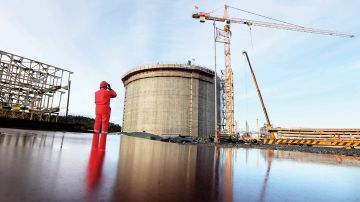INEOS Upstream may be INEOS’ newest business.
But the people driving its new energy business are not new to fracking. On or off shore.
On shore, INEOS is working with the three Americans who pioneered the development of shale gas in the US which has led to a manufacturing renaissance.
Off shore, they have acquired a team who has been drilling and fracking safely for natural gas for years.
All are confident that INEOS – with its expertise above ground, handling flammable gases across its 65 manufacturing sites – can become the first company in the UK to safely extract the vast reserves of shale gas currently trapped in rocks thousands of feet underground – and, in doing so, change public perception.
“We think we can bring something unique to the emerging shale gas industry,” said Tom Pickering, INEOS Shale’s Chief Operating Officer who worked on a North Sea oil rig for years.
Doug Scott is head of drilling at INEOS Breagh, a subsidiary of INEOS Upstream.
“We have been one of the most active exploiters of fracking in tight sandstone gas fields in the southern North Sea over the past four years,” he said. “We have used the technique to get the gas out quicker and to access gas that was previously uneconomical to extract.”
Shale gas is the same as North Sea gas. They are both natural gas. The only difference is the North Sea gas is extracted from sandstone situated around 3km (almost 2 miles) under the seabed and on shore INEOS would be extracting it from shale up to 5km (3 miles) underground.
Doug and his team had – up until October – been working for DEA. That changed when INEOS bought the German firm for several hundred million dollars, and, with it, the responsibility for ensuring the supply of gas for 1 in 10 homes across the UK.
INEOS Breagh operates four platforms in the southern North Sea and owns interest in 16 exploration licences.
INEOS’ decision to buy – when all around seemed to be selling – has been seen as a ground-breaking move into the energy sector.
Where others saw troubled waters – brought on by rising costs and plummeting profits – INEOS saw a huge wave of opportunity.
That opportunity to acquire an immense amount of expertise – while improving the life and efficiency of these platforms without compromising on safety – was too good to miss.
To help grow the business, INEOS will be relying on its new team of geologists, geophysicists and well construction experts who are now working for INEOS Breagh.
The new team work well with INEOS Group because they share a similar ethos.
“Safety and efficiency are paramount to us,” said Doug. “The design and planning work we did before we fracked our very first well was critical to its success and it cannot be overestimated. The time you spend to get everything right pays dividends during the operational phase.”
He said the plans – and contingencies agreed in the event of something going wrong - ensured the team could manage the inherent uncertainties of drilling and fracking wells.
“As always during the operational phase, in the event that operational progress conflicts with safety, safety always takes priority,” he said.
Doug said safe and efficient operations relied on team competency and effective communication between those operating the rig, the frack vessel and the platform.
At INEOS Breagh they fitted essentially a filter in the well to stop the proppant (primarily the sand) from reaching the surface during gas production. It meant the fracked well could be put on line 12 months ahead of an alternative technical solution being found.
“The downhole screens were a first for fracked wells in the UK’s continental shelf in the southern North Sea,” said Doug. “But this simple technology potentially opens up all sorts of opportunities for our future fracked gas field developments.”
And at Clipper South they sold the clean-up gas from the well instead of flaring it.
“That was a first for us as well,” said Doug. “It took an enormous amount of effort and collaboration within the organisation to integrate the safety and productions systems, but by doing that, we not only captured about 300 tonnes of CO2 but it also created £4.3 million in revenue from the sales gas.”
The platforms, which INEOS inherited as part of the deal, are relatively new, well managed and remotely controlled.
“That was part of the appeal,” said Geir Tuft, CEO of INEOS Breagh.
As INEOS moves further into the energy business, INEOS Shale will be hoping to learn valuable lessons from the team at INEOS Breagh.
“We will be looking to take advantage of the new family ties in all areas by sharing resources and experiences,” said Geir.
Since the acquisition, he has been working on a robust plan to improve the efficiency of the business, especially in light of falling oil and gas prices.
Three years ago oil was selling at $110 a barrel; today it is below $40.
“We need to be able to manage reduced cash flows to ensure the business is robust in all conditions,” he said.
















